The Economy Speeds Up and Housing Downshifts
Expanding vaccination efforts, the emergence of warmer weather, and the passing of greater than previously expected fiscal stimulus point to an economy ready to take off once COVID-19-related effects begin to subside. Our growth expectation for 2021 is now 5.3 percent compared to December’s forecast of 4.5 percent, and growth in 2022 is now forecast to be 3.6 percent, an upward revision from 3.2 percent. We believe economic output likely flatlined or even pulled back in the final two months of 2020. However, we expect a reversal of any recent softness starting in the late spring when growth is expected to accelerate. Our final 2020 forecast for real gross domestic product (GDP) growth was downgraded slightly to negative 2.7 percent as we pushed more of the forecast recovery into 2021.
We expect inflationary pressures to become evident in the second half of 2021. This expectation, combined with the Federal Reserve’s stated intention of letting inflation exceed its long-term target for “some time,” led us to increase our forecast inflation rate in the fourth quarter of 2021 and beyond. We forecast core personal consumption expenditures (PCE) inflation to reach 2.4 percent on an annual basis by year-end 2022.
Meanwhile, we expect housing activity to remain strong in 2021; however, we believe it is likely to shift down a gear following its torrid pace during the second half of 2020. A near-term continued slowdown in home sales is likely, but for the year, we expect both home sales and single-family housing construction will be higher than 2020. Total home sales are projected to be 3.8 percent higher in 2021 than in 2020, while single-family housing starts are expected to rise by 12.5 percent.
We also upgraded 2020 home price growth to 10.3 percent annually (up from 6.4 percent) and our 2021 home price growth forecast to 4.2 percent (previously 2.1 percent), as measured by the FHFA Purchase-Only Index. This higher home price outlook, combined with upward revisions to our sales outlook, led to an increased forecast for mortgage originations. Total originations in 2020 were $4.4 trillion ($125 billion higher than last month’s forecast), while 2021 and 2022 originations are expected to decelerate to $3.9 trillion (up $440 billion from the prior forecast) and $3.2 trillion (up $378 billion from the prior forecast), respectively.
Economic Growth Could Stall if Downside Risks Materialize
The most important uncertainty to the current forecast is the future path of the COVID-19 pandemic, including the speed of deployment and overall effectiveness of the vaccines. Thus far, vaccine distribution rates have been slower than anticipated. However, we maintain our forecast assumption that by mid-spring, warmer weather and widespread inoculations will result in the removal of many economic behavioral restrictions, both on a personal and policy level.
Another major risk to the current forecast is the future path of interest rates. Our interest rate forecast is a function of market rates at the end of December, and the 10-year Treasury yield has since risen over 20 basis points as of this writing. Market-based measures of inflation expectations have also trended upward in recent weeks, with the 5-year breakeven rate now exceeding 2 percent. While these changes are still modest, if interest rates were to continue to meaningfully rise, they would likely dampen economic, housing, and mortgage activity relative to our baseline forecast. A sudden, sharp jump in interest rates due to changing future expectations could cause an equity market sell-off and restrain home sales and prices, as low mortgage rates have been necessary to maintain affordability over this past year in light of rapidly rising home prices.
Future fiscal policy also remains uncertain. We believe the recent change in control of the U.S. Senate increases the likelihood of additional fiscal stimulus. However, it is unclear whether or when such legislation would be passed or what might be included in the final bill. Therefore, our forecast does not explicitly incorporate any additional fiscal stimulus at this point.
Further Recovery Waiting at the Starting Line
As long as the current COVID-19 resurgence and related containment policies limit consumers’ opportunities to spend on many services, we expect economic growth to be sluggish. Real consumer spending fell over the month of November, coinciding with a surge in COVID-19 cases. Furthermore, downward revisions to PCE in prior months left October at a lower level than previously thought. However, due to the outsized seasonal adjustments to economic data around the holiday season and the abnormal COVID-driven temporal patterns around retail spending and travel, measuring the extent of the slowdown is a challenge. High frequency data have been volatile week-to-week, but measures of credit and debit card spending suggest that November’s weakness may have been due, in part, to pushing typical Black Friday retail spending to the weeks following. This, coupled with a 3.1 percent rebound in auto sales in December, suggests that November weakness may have been partially reversed in December.
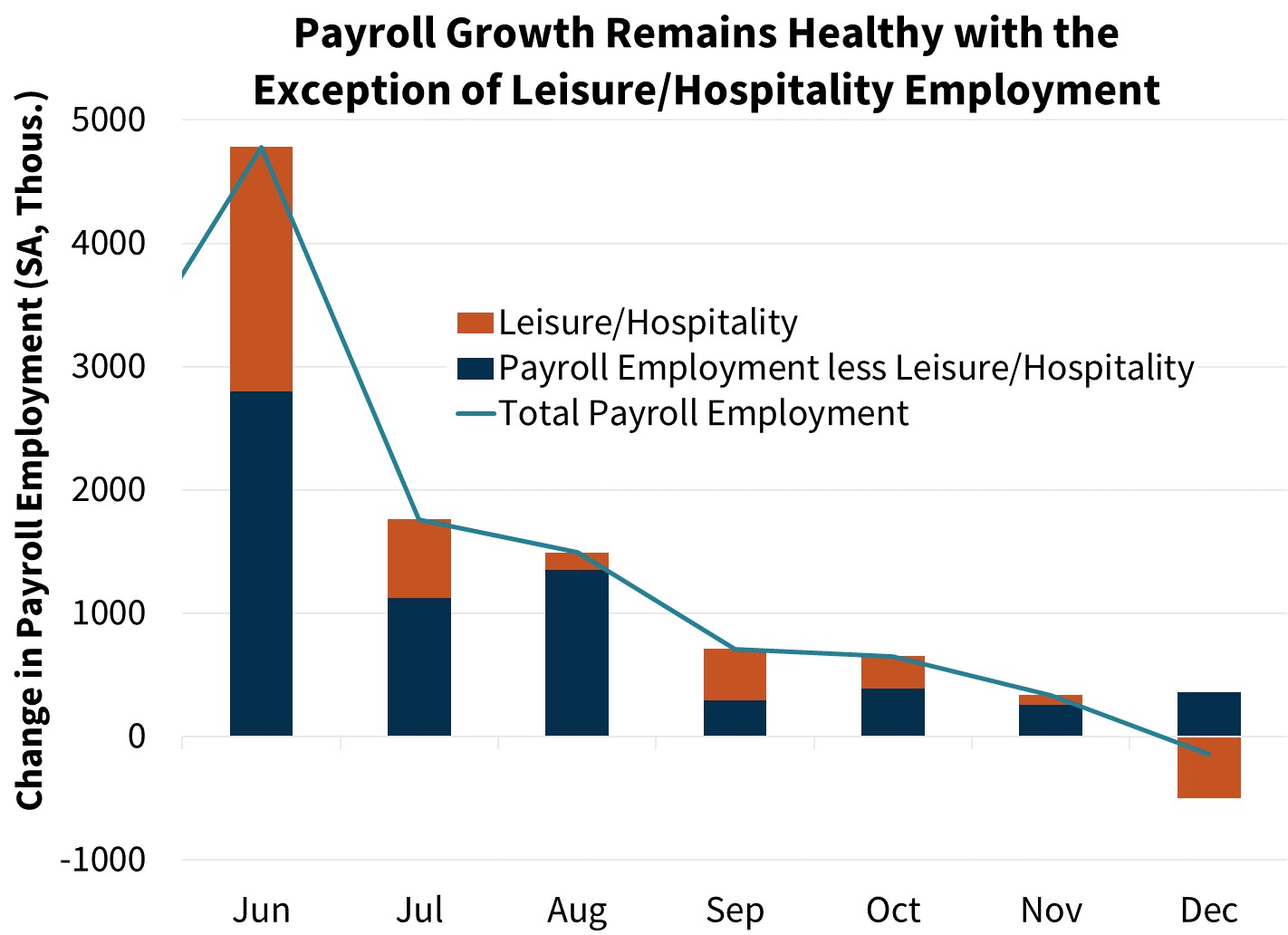
On the other hand, measures of food service activities clearly pulled back in December and the month’s labor market report showed a loss of 140,000 in payroll employment, the first decline since April and below consensus expectations. The loss, on net, was entirely due to a large decline of 498,000 jobs in the leisure and hospitality industries, the sectors most directly hit by the COVID-19 resurgence and localized shutdowns. In contrast, solid job gains occurred is most other areas, including retail, construction, manufacturing, healthcare, and business services. Combined with continued strong manufacturing activity measures, this suggests that the underlying recovery is still intact. Still, on balance, we downgraded our Q4 2020 and Q1 2021 growth expectations to 3.2 percent and 2.6 percent annualized, from 5.4 percent and 2.8 percent respectively.
Hitting the Post-COVID Accelerator
Looking past COVID-19, we expect the current business cycle to develop much differently than recent prior recoveries. The recessions of 1990, 2001, and 2008 were all driven, at least in part, by the popping of asset bubbles and/or stresses in the financial system. They were followed by long, increasingly slower recoveries, accompanied by declining inflation and interest rates. While the reasons are not fully understood, contributing factors include households and firms requiring time to rebuild their wealth and rectify imbalances, keeping demand growth constrained. The current cycle may bear a greater resemblance to earlier periods with sharper recoveries and could include a shorter expansion as pricing pressures build quicker and new cyclical risks emerge sooner. Both the periods of 1970-1983 and 1948-1960 experienced four recessions. While reasons for those downturns varied, they were all followed by comparatively rapid recoveries in which “full employment” was usually reached within a couple years and often accompanied by inflationary pressure. While there are many differences between those prior economic periods and today, they illustrate the potential for faster recoveries and shorter cycles when asset bubbles and financial crises do not drive downturns.
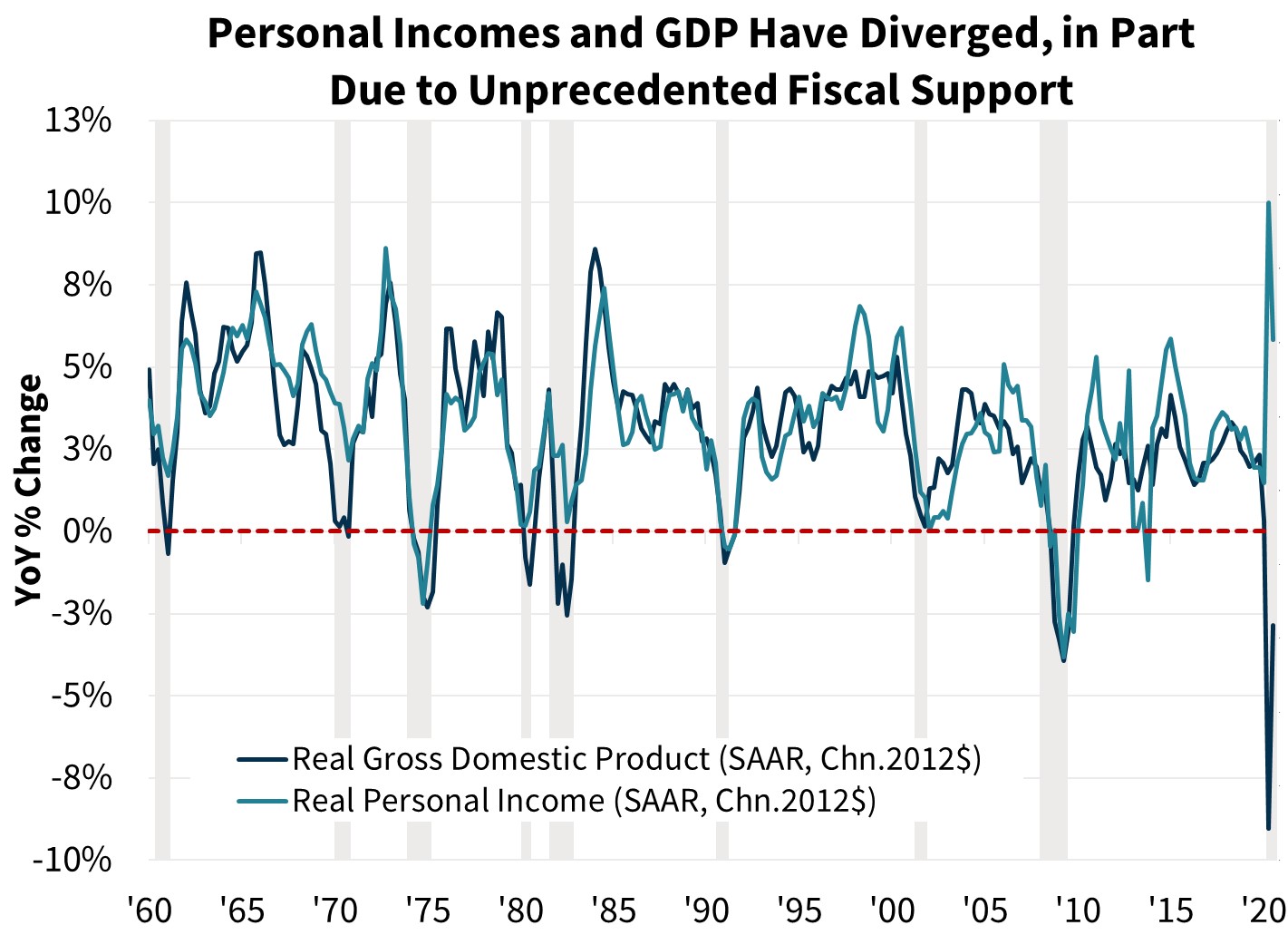
Aggregate personal income continued to grow over the past year augmented by massive income transfers, despite a sharp output contraction. Thus, households were able to build up a large pool of savings, nearing $1.6 trillion beyond the prior growth trend, and counting. The most recent round of stimulus checks and any additional legislation passed would likely add to these savings levels. Additionally, rising home prices and equity values mean that households, on average, do not need to maintain an elevated saving rate to replace lost wealth. We therefore expect consumers will be both able and willing to drive further consumption recovery after COVID-related restrictions are lifted. Our baseline forecast implies November’s elevated saving rate of 12.9 percent will trend downward to 8.7 percent by the end of 2021, a level still modestly higher than the pre-COVID average of 7.5 percent.
Therefore, our baseline forecast remains somewhat conservative regarding consumer behavior, even with an expected 2021 annual growth projection of 5.3 percent, which would be the fastest year-end annual GDP growth rate since 1984. Our forecast assumes that acquired savings will not be drawn down meaningfully, but rather that spending converges back to a more normal relationship to incomes. Therefore, assuming COVID-related restrictions abate, and no other shocks occur, the consumer could have the capacity to drive rapid growth even faster than we are forecasting.
In contrast, a more negative viewpoint would be that households will be cautious in their financial decisions in the wake of the unprecedented past year. However, we have seen little evidence of this attitude. Consumer spending growth was remarkably strong in the initial phases of recovery last year, when virus cases began to decline and the initial shutdowns were lifted. Since then, a surge in home sales indicated a willingness to purchase “big ticket items,” and discretionary durable goods consumption held up exceptionally well at the end of 2020. While some of this was due to substitution away from service expenditures, it suggests that consumers are not hesitant. Auto sales in December reached 96 percent of their pre-COVID peak, just 10 months after the downturn began. In contrast, from the peak just before the Great Recession, it took 69 months for new auto sales to return to such a level. Further, survey evidence suggests a similar conclusion, as consumer confidence and business sentiment held up better this year than during previous economic downturns. The University of Michigan and Conference Board measures show recent readings similar to 2014 levels, which was a full five years after recovery began in the prior cycle. Lastly, most unemployed individuals continue to report their layoffs as temporary, and job openings remain close to 2017 levels. As a ratio of all unemployed persons, this represents 3.7 times more jobs available relative to the end of 2009. These factors suggest comparative optimism on the part of both the unemployed and employers.
Economic Engine Overheating?
We believe there is a risk that recent years’ experience of consistently low consumer price inflation could lead to complacency regarding inflation’s potential return. The Fed continues to signal its desire for inflation to average 2.0 percent over time, recently changing policy guidance to indicate a willingness to allow it to “run hot” – or above the 2 percent target for some period. Our baseline assumption is that the Fed will tighten when needed, keeping any increasing inflation modest, although their guidance is insufficient to generate a high degree of confidence regarding how they will achieve this goal. Our annual forecast for core PCE inflation implies that it will exceed 2 percent on an annualized monthly basis around the end of 2021, but that it will not exceed 2.5 percent during 2022. However, inflation has risen more quickly in the past when monetary authorities were caught off guard. Once realized inflation rises, expectations of future inflation may become unanchored, and when that occurs the task of taming it becomes more difficult. We believe this to be a significant risk to the forecast.
The large expansion of the Fed’s balance sheet over the past year is not a new phenomenon, but the results may be more inflationary than in prior periods. There is an important difference between prior rounds of Quantitative Easing (QE) and the current period. The Fed’s earlier large-scale asset purchases coincided with encouraging banks to retain excess reserves at the Fed. Therefore, most of the new money printed did not circulate broadly within the economy. The Fed’s goals were more to shore up liquidity in the financial system and to drive down long-term interest rates. In contrast, current Fed purchases are being done in conjunction with unprecedented levels of expansionary fiscal policy, using them to fund transfers to households and firms. This has resulted in much faster growth in the broader money supply. The M2 money stock metric, a commonly used measure of the aggregate amount of currency, deposits, and other liquid “money-like” assets in the economy, was 25 percent higher in December 2020 than a year earlier, the fastest annual growth rate on record. Included in this total are household checking account balances, which grew by $700 billion between the first and third quarters of 2020. This represents potential for near-term consumer spending power that can be unleashed. While money supply does not have the short-run correlation to nominal GDP that it once did, in the long run, the summation of real output growth and cumulative price increases has tracked money growth. Given the money supply rise has been much greater than the size of lost economic output, we believe there is the potential for faster inflation going forward once the labor market recovers.
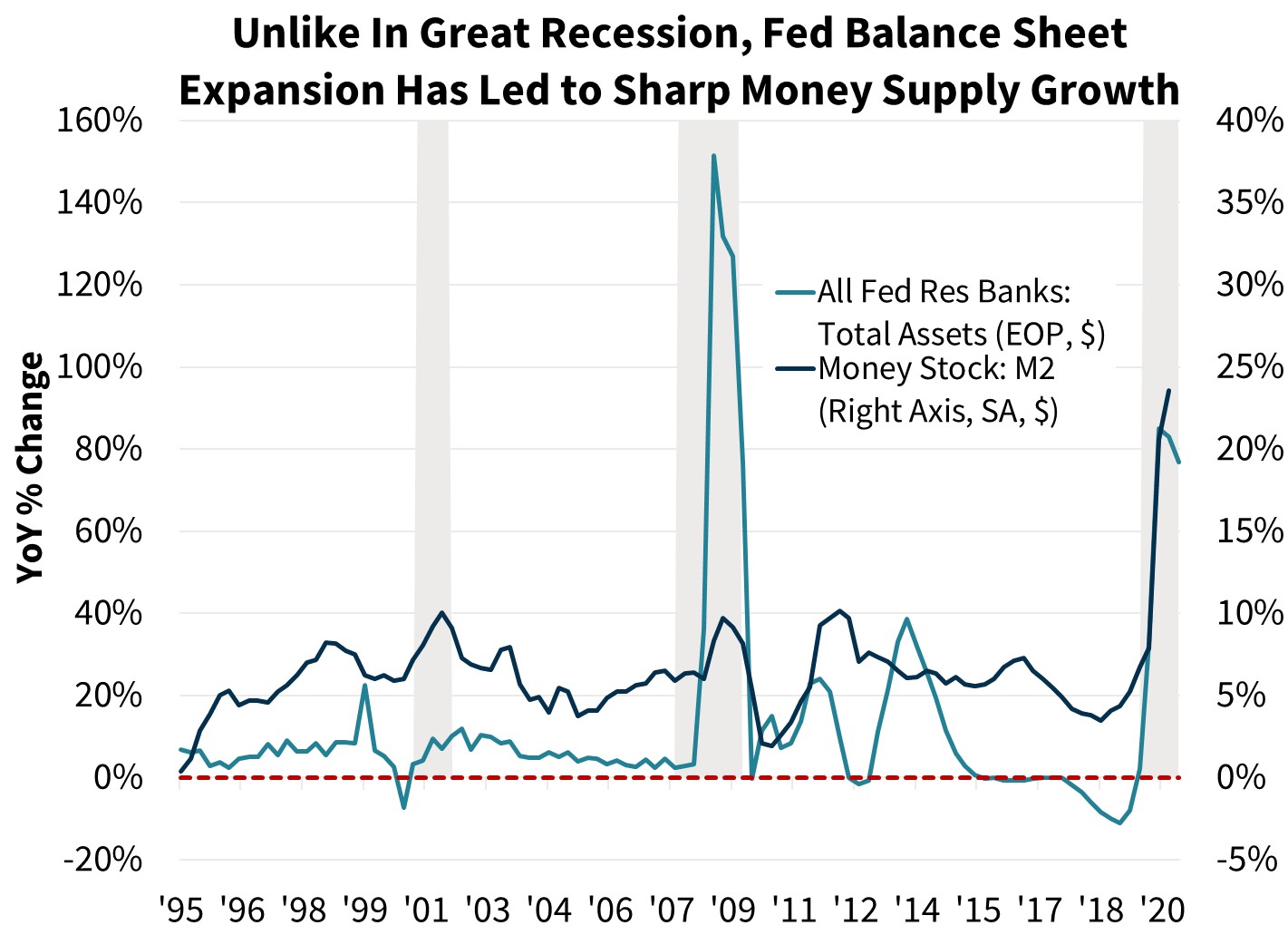
Strong spending growth supported in part by the large money supply expansion may also bump up against concurrent weakness in the productive capacity of the economy, further adding to pricing pressures. There is a risk that COVID-19-related restructuring of the economy will be significant, as a meaningful amount of labor and capital will need to relocate, retrain, or repurpose. This type of shift does not happen overnight. Underutilized retail space, a shift away from office workers commuting to core business districts, migration to different metros, and the closing of eating establishments are all examples of a short-run shrinking of the production capacity of the economy. If supply chain disruptions from the spring also lead firms to prioritize resiliency going forward, as opposed to minimizing cost, this too could represent a contraction in the potential output level.
Additionally, a recent Census Bureau estimate of the 2020 population suggests that immigration has come to a standstill, meaning the potential labor force is likely smaller now than the pre-COVID trend would have indicated. Public policy changes, such as more generous unemployment benefits and a higher minimum wage, may also contribute to lower labor utilization. While the former helps alleviate hardship and supports the demand side of the economy, generous benefits may also lead to more workers being reluctant to relocate or retrain relative to prior recessions, keeping more on the sidelines for longer. As for the latter, the non-partisan Congressional Budget Office estimated in 2019 that, while a $10 national wage floor would have a benign effect on the total level of employment, a $15 rate would most likely lead to a reduction in employment of 1.3 million jobs. That would translate to almost an additional full percentage point in the unemployment rate. Putting all these factors together, compared to recent business cycles, we believe there is a real possibility of faster realized inflation both in absolute terms and relative to the level of measured labor market recovery.
Housing Shifting Down a Gear
The impressive surge in housing activity over the second half of 2020 helped drive the initial phase of economic recovery. However, we believe this stage has likely passed, as last year’s delayed homebuying season comes to an end. While we forecast that housing demand will continue to be strong, based on an improving labor market and favorable demographic factors, we believe the pace of activity will likely slow over time toward its underlying trend. We do not expect mortgage rates to decline further, and inventories of homes for sale remain extremely tight. Existing home sales fell 2.5 percent in November. Pending sales, which lead closings by 30-45 days on average, also fell over the month by 2.6 percent, suggesting lower home sales in December. This is consistent with the December reading of the Fannie Mae Home Purchase Sentiment Index®, which fell 6.0 points. While we project existing home sales will rise 3.7 percent in 2021, the monthly pace is likely to decelerate through much of the year. Consistent with this expectation, home price appreciation is also forecast to decelerate as the year unfolds.
New home sales fell in November, slipping 11.0 percent over the month. While some of this large decline likely follows the general softening of sales, we believe it was partially due to an unsustainable relationship between housing starts and home sales over the past half-year. Home sales had been sustained by homebuilders drawing down inventories and signing contracts for homes not yet started. Some combination of sales pulling back and starts accelerating was therefore necessary to bring about a sustainable balance. Additionally, prior months’ sales data were revised downward significantly, meaning that much of this starts/sales gap was revised away, putting the sales pace on comparatively stronger footing going forward. After a modest pullback in the near term, largely reflecting a rebalancing of the number of early- and late-stage homes under construction, we expect single-family housing starts to exhibit comparable strength going forward, with 2021 single-family starts 12.5 percent higher than in 2020.
Despite this positive view on single-family construction, from a GDP perspective, the direct contribution of housing investment, which surged over the past two quarters, is not expected to be a driver of growth in 2021. In fact, on a Q4/Q4 basis, we forecast residential fixed investment (RFI) to fall 3.8 percent. Some of this weakness is due to the time lag in multifamily construction expenditures from the initial deceleration in starts last year. However, the bulk of the decline is from a heightened Q4 2020 starting point driven disproportionately by brokers’ commissions and home improvement spending. Our forecast for Q4 2020 implies that nearly 60 percent of RFI fell into one of these two categories. Consistent with our view on home sales, commissions are expected to pull back. Home improvement spending has historically been highly correlated with both home sales and rising home equity (which allows owners to borrow against their home’s value). With the sales pace and home price appreciation expected to decelerate, we believe home improvement spending is likely to follow suit. Additionally, some portion of home improvement spending in recent quarters was likely driven by a higher share of remote-working homeowners and a greater number of people spending more time at home. We expect much of this impetus to wane as COVID-related social distancing measures begin to be removed. It is possible, however, that this activity proves more durable than we expect, as society adapts to a post-COVID world.
Housing Further Down the Road
How the unusual events of the past year shape housing trends in the long-term remains an open question. Our view is that the pandemic’s lasting effects will include a modestly higher pace of home sales than otherwise would have occurred, as well as comparatively stronger support for new construction. While we do not predict a major exodus from large urban areas, we see the expansion of remote working as enabling a greater share of households to migrate to the suburbs and less expensive metros even after the pandemic recedes, as companies compete for talent in a tightening labor market. People reassessing their housing choices and continuing to relocate to new locations could drive a modestly elevated level of home sales. If this shift in demand is toward less expensive geographies with stronger housing supply responses, either due to greater land availability or less restrictive zoning, this would bode well for new single-family construction. As a result, our forecast for existing home sales converges to a level modestly above the pre-COVID trend, while our outlook for single-family starts is significantly more positive. If these assumptions are proved correct, multifamily housing demand may decline in at least some of the more expensive metro areas, keeping multifamily housing starts below their pre-COVID pace.
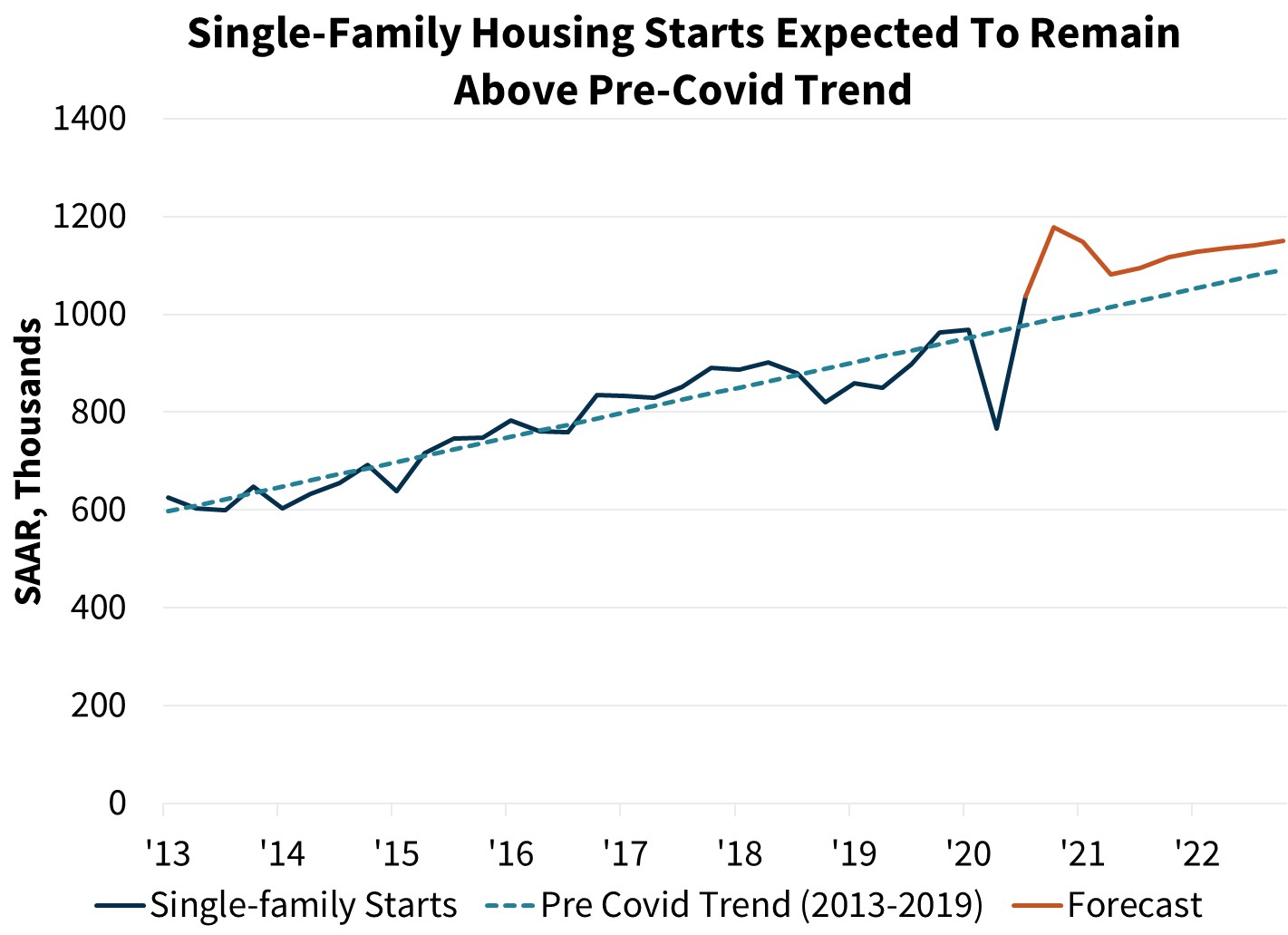
For more on multifamily market conditions please see the January 2021 Multifamily Market Commentary.
We expect refinance origination volume in 2021 to come in at $2.2 trillion, a 20 percent increase from last month’s forecast, though still a pullback from the all-time high volume of $2.8 trillion in 2020. We believe there remains further capacity for strong refinance volume in 2021, especially in the first quarter of the year, supported by a continued low-rate environment, strong incoming application data, and an upgraded outlook for home price growth. At current interest rates, we estimate 67 percent of outstanding mortgage balances still have at least a half-percentage point incentive to refinance. Volume is projected to decline further to $1.4 trillion in 2022, though remain elevated from an historical perspective, as interest rates stabilize and the share of mortgages with a rate incentive to refinance begins to wane.
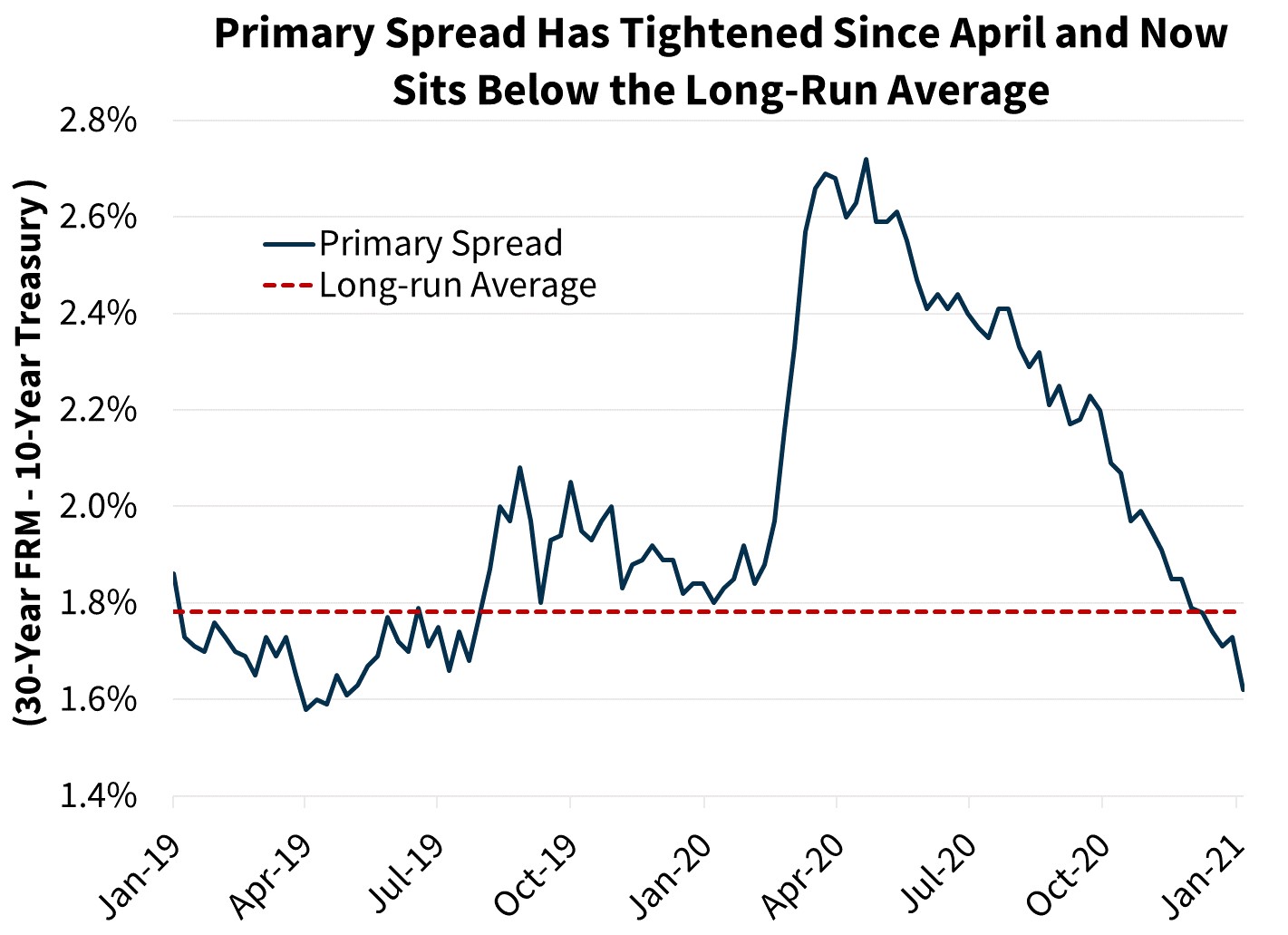
Mortgage rates fell again in early January to 2.65 percent, another record low. However, the continued decline in mortgage rates may be coming to a close as the 10-year Treasury yield jumped in early January. The move up in the 10-year yield narrowed mortgage spreads, with the primary spread (30-year mortgage rate minus the 10-year Treasury yield) falling to approximately 160 basis points, the lowest spread since mid-2019. While the spread compression indicates falling lender margins, we believe mortgage lenders will be willing to absorb some of this cost before passing it on to consumers through higher mortgage rates.
Economic & Strategic Research (ESR) Group
January 12, 2021
For a snapshot of macroeconomic and housing data between the monthly forecasts, please read ESR’s Economic and Housing Weekly Notes.
Data sources for charts: Bureau of Labor Statistics, Bureau of Economic Analysis, The Federal Reserve Board, Census Bureau, Fannie Mae ESR Group, Freddie Mac.
Opinions, analyses, estimates, forecasts and other views of Fannie Mae's Economic & Strategic Research (ESR) Group included in these materials should not be construed as indicating Fannie Mae's business prospects or expected results, are based on a number of assumptions, and are subject to change without notice. How this information affects Fannie Mae will depend on many factors. Although the ESR group bases its opinions, analyses, estimates, forecasts and other views on information it considers reliable, it does not guarantee that the information provided in these materials is accurate, current or suitable for any particular purpose. Changes in the assumptions or the information underlying these views could produce materially different results. The analyses, opinions, estimates, forecasts and other views published by the ESR group represent the views of that group as of the date indicated and do not necessarily represent the views of Fannie Mae or its management.
ESR Macroeconomic Forecast Team
- Doug Duncan, SVP and Chief Economist
- Mark Palim, VP and Deputy Chief Economist
- Eric Brescia, Economist
- Nick Embrey, Economist
- Rebecca Meeker, Financial Economist
- Richard Goyette, Business Analyst
